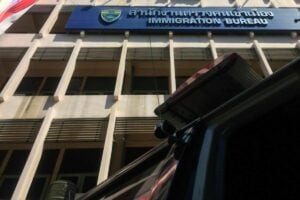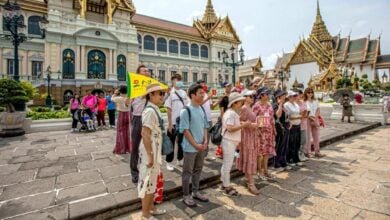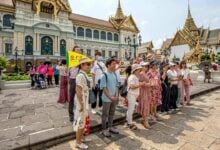Guide to obtain a Thai visa on arrival as a cruise ship passenger

If you are in the process of arranging a journey to the Kingdom of Thailand, particularly as a maritime passenger, there is one pivotal document that you must secure – the Thai Visa on Arrival (VOA). However, this should not cause undue stress; obtaining the VOA is less intricate than it may initially seem.
Thailand offers numerous venues where you can obtain your VOA. These locations include high-traffic airports like Suvarnabhumi and Don Muang in Bangkok, along with multiple immigration checkpoints scattered across the country. The crucial aspect is being aware of the correct procedures and locations.
In this detailed guide, we will illuminate the necessary steps to acquire your Thai VOA. This entails accurately filling out the TM 6 form and providing proof of financial capacity. We cordially invite you to peruse this information as we explore every facet of obtaining a Thai visa for cruise ship passengers.
Types of Thai visas for cruise ship passengers
Esteemed cruise ship travellers. Let us engage in a thorough discussion concerning the diverse visas you may necessitate for your prospective voyage to Thailand. The visa requisite is principally contingent on the delightful activities you have arranged and the duration of your intended stay in this tropical utopia. You have three fundamental alternatives at your disposal: Visa on Arrival, Electronic Visa on Arrival, or Tourist Visas.
Visa on arrival
If you’re planning a short but sweet visit to Thailand, say no more than 15 days of pure tourism fun, the Visa on Arrival might just be your ticket. Just make sure you’ve got a valid passport with at least six months left on it, enough dough in your pocket to enjoy your stay fully, and some proof of where you’re heading next. When you’re ready, just fill out the application form and bring all your documents to one of the many Thai immigration checkpoints that can hook you up with a VOA. Best part? It’s super quick – usually done within an hour.
Electronic visa on arrival
An alternative to expedite the VOA process is the eVOA. Introduced to reduce long immigration lines, this visa type is currently available to only passengers arriving via Suvarnabhumi Airport. The application process is largely similar to the traditional VOA, except it’s completely online. It’s advised to apply ahead of arrival for a smooth transition into Thailand.
Tourist visas
If your stay extends beyond 15 days, you’ll need a Tourist Visa. Application procedures differ and typically involve more documentation and processing time. Keep in mind that Visa types and processes can change, so checking updated information from official Thai Government sources like ‘Thailand eVisa’ is recommended before you embark on your cruise journey to Thailand. Now, you’re prepared for your cruise trip to Thailand with the right visa knowledge.
Eligibility for visa on arrival

When planning your visit to Thailand as a cruise ship passenger, understanding the eligibility criteria for a Visa on Arrival (VoA) is pivotal. This section will shed light on two main prerequisites: Passport requirements and proof of onward travel.
Passport requirements
Before applying for a Thailand VoA, confirm that your passport remains valid for at least six months from the date of your entry into Thailand. Moreover, ensure that you have a copy of your passport’s photo or information page. A soft copy or a photographed version of the same becomes essential for getting off the cruise ship and exploring Thai ports. If you’re a Nigerian citizen or passport holder, an extra step becomes crucial. It involves obtaining a Certificate of Clearance from the NDLEA, authenticated by The Ministry of Foreign Affairs of Nigeria and the Royal Thai Embassy in Abuja, Nigeria.
Proof of onward travel
In addition to the passport guidelines, proof of onward travel is mandatory. This proof certifies that you’ve arrangements to leave Thailand, post your cruise ship journey’s end. Any valid evidence like a confirmed flight or cruise ship booking acts as proof of onward travel. Lastly, you must provide assurances that you’ve sufficient funds to cover your stay in Thailand. Without these assurances, obtaining a VoA for your travel to Thailand can become a hurdle.
Application process for Thai visa as a cruise ship passenger
Thailand’s gorgeous beaches, historic ruins, and vibrant cities attract many cruise ship passengers every year. Of course, to enjoy all this beauty, passengers must navigate the Thai visa application process. Specifically, we’ll look at how to get a Visa On Arrival (VOA) and the role online pre-registration and procedures at arrival ports play in this process.
Online Pre-Registration
Before setting sail, cruise ship passengers can simplify their Thai eVOA application process by pre-registering online. Pre-registration is not a complicated process, involves creating an account and filling out a visa application form online.
Start by applying as an individual using the application platform. Next, choose to apply for a new visa and check your eligibility. Selection of the type of tourist visa is crucial as it has to correlate with your planned activities and length of stay in Thailand.
Following that, one of the important steps includes uploading a scan of your passport biodata page. Your personal information also needs your attention. Fill out the details like home address, phone number, nationality, date of birth, and marital status. Got a job? Include your employment details, too.
Procedures at arrival ports
But, there’s more to remember when you arrive at a port of entry in Thailand. Navigate to one of the many VOA checkpoints. These include international airports, seaports, and land borders such as:
-
Suvarnabhumi Airport
-
Don Muang International Airport, Bangkok
-
Chiangmai International Airport, Chiangmai
-
Phuket International Airport, Phuket
Passengers must undertake visa procedures upon arrival. Here’s where you submit your application form (if not done online). Remember to carry your passport and other required documents with you, they’re essential.
Required documents for applying

In your quest to complete the Thai eVOA application process as a cruise ship passenger, it’s paramount to have the necessary documents on hand. These include passport photos and completed application forms. Under the following subsections, we uncover information about each document.
Passport photos
As a crucial part of the process, you’ll need to provide a recent passport-sized photograph. This shouldn’t be older than six months. It’s essential to note that your facial features must be visible in the photograph, and it should be coloured.
Also, remember to bring two copies of this photograph. Your image in the photo must reflect your current appearance, so if you’ve recently gotten a new haircut or grown a beard since the photo was taken, you might need to take a new one. Contingent on conducting the application process onboard, you can expect queuing times to apply, and fees – presently set at 85 USD per person – will be billed to your onboard account at the current exchange rate.
Completed application forms
An additional document for applying is the thoroughly completed visa application form. You can complete this form online via the iVisa platform. It’s critical to make sure the information entered is accurate. This includes details about your travel such as your flight type – whether it was a charter or scheduled flight, whether you are a part of a tour group, your accommodation details in Thailand, and the purpose of your visit.
Furthermore, there’s the aspect of your yearly income which, excluding no income, can be all-encompassing. It’s essential that the financial information you provide is accurate as claiming no income could suggest you aren’t capable of financing your stay in Thailand.
Costs and validity
Knowing the costs associated with visa applications and understanding the validity of issued visas remain crucial aspects of planning your journey to Thailand.
Visa fees
Fees do form a significant part of visa applications. For the Thai Visa on Arrival (VOA), expect to part with approximately USD 85, displayed on your onboard account. This figure covers both the visa itself and the service charges related to obtaining and processing your visa. Bridging the gap between you and representatives of embassies, and consulates, is a worthwhile investment, immigration agents can offer invaluable support. But remember, they come with a service fee, an additional cost factored into your travel budget.
Duration and extensions
Upon obtaining the Thailand eVOA, you can enjoy a stay of no longer than 15 days on a single entry permit. However, the more flexible eVisa can accommodate you for up to quite a substantial 90 days. This introduces multiple entry options, contrasted against the shorter period and single entry provided by the VOA. Do bear in mind that entry approval remains at the discretion of immigration officers, not a guaranteed right based on document possession. Despite this, presenting your documents in hard copy at Passport Control often expedites your processing and eases congestion at the airport.
Arrival and immigration procedures
The final stage in obtaining your Thai Visa on Arrival (VOA) involves navigating through immigration and customs. This section provides comprehensive detail on how to optimise this process.
Entry points for cruise passengers
When travelling to Thailand as a cruise ship passenger, you must be aware of the various entry points where you can obtain a VOA. These include airports, sea ports, and border checkpoints. There are over 20 permitted checkpoints spanning across the country. Notably, significant entry points include the Suvarnabhumi Airport, Don Muang International Airport in Bangkok, Phuket International Airport, Samui Airport in Surat Thani, and sea ports such as the Bangkok Harbour Immigration Checkpoint and Phuket Immigration Checkpoint.
Customs and import regulations
As a traveller, you must be familiar with Thailand’s Customs regulations. When entering Thailand, you must complete a mandatory Customs Declaration Form. This document helps the Customs Department track items brought into the country that might be subject to import taxes or restrictions.
You’re allowed to bring personal belongings, including a reasonable amount of clothing and toiletries, without facing customs duties. Certain items, however, face strict restrictions, such as unprocessed gemstones, fake and pirated goods, and, quite importantly, weapons of any kind. The prohibition extends to plants and animals unless you have obtained a prior permit, considering the country’s biodiversity protection laws.
To overcome a Thai visa denial, thoroughly review the reasons for rejection, gather necessary documentation, address any issues, and consider seeking advice from an immigration expert or consulting the Thai embassy for additional guidance to improve your chances of turning the rejection into an approval.

































